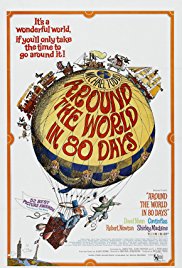The earth rotates on its axis from West to East, but relative to the earth, sunlight comes from only one direction. Therefore, both daylight and night move across the earth as it rotates. In order to compensate for the earth’s rotation and to avoid requiring half the world to go to work in the dark, the earth is divided into 24 time zones. Each zone is wide enough to approximate one hour of the march of daylight and night across the globe. Since the earth rotates from West to East, if a person is traveling in the same direction and is viewed from the standpoint of the sun, he is going faster than the earth rotates on its axis, faster than daylight and night. When he travels from West to East during the day he is catching up to the evening, and leaving daylight behind. In order to compensate for this effect, the traveler will have to set his clock ahead one hour as he enters each new time zone. For example, a person traveling from Los Angeles to New York will pass through three time zones. Thus, 9:00 a.m. on the West coast is 12:00 noon on the East Coast. The process is reversed when someone travels from East to West. That person is moving against the Earth’s rotation and will tend to remain in daylight or night. He will have to set his clock back one hour, as he moves from one time zone to another.
At some point, if a traveler goes all the way around the world, he will travel through all 24 time zones and have to adjust his calendar, as well as his watch. The International Date Line, in the middle of the Pacific Ocean is the agreed upon line which separates one day from another.
Phileas Fogg traveled around the world beginning in England, going to Europe, the Middle East, India, Asia, across the Pacific to America, and then back to England by crossing the Atlantic. In other words, he traveled from West to East. Fogg was traveling around the Earth’s axis a little faster than the Earth itself, a little faster than dawn and sunset.
Traveling from west to east, Fogg had to set his clock ahead one hour on each occasion that he entered a more easterly time zone. But while the clock advanced one hour when he entered a new time zone, the actual amount of time that Fogg had spent on his journey did not increase. Since Fogg, on his journey around the world, went through each of the 24 time zones, his clock advanced 24 times showing 24 hours of artificial time.
Fogg was not the first person to go around the world. In order to correct for the lost day that occurs on the 24th change of time zone, an artificial line called the International Date Line, was drawn on maps and globes from North to South across the Pacific Ocean. If you are standing (or sailing) west of the International Date Line, a person to the East of the Date Line, according to the calendar, is existing in yesterday in relation to you. You, being west of the Date Line, are existing in tomorrow as to him or her, even if you are only a few feet or a few miles away.
When Fogg was counting his 80 days, he forgot this effect. Since he had traveled from West to East, he was artificially gaining an hour of time with each time zone. When he crossed the International Date Line, he should have put his calendar back one day, giving him an additional calendar day to complete his wager.
The lives of many well-to-do Englishmen in the Nineteenth and early Twentieth centuries centered around their clubs. They could eat at their club, sleep at their club and relax at their club. The clubs were very resistant to change. They had strict rules barring the admission of women and people of color to the club premises and they rigidly restricted membership to white males.
Flamenco dancing comes from the folk music of Andalusia, a region in Southern Spain. It combines Moorish and Gypsy influences and requires great skill and training. See the Learning Guide to Strictly Ballroom for more on Flamenco.
Bullfighting is a traditional entertainment in Spain. It is also popular in modified forms in Latin America. See Learning Guide to “Carmen”
Hindus, the dominant religious group in India, believe that cows are sacred animals which cannot be killed and should be given special privileges. When Passepartout tries his skills as a bullfighter, skills that were popular in Spain, with a bull eating from a flower stall in Bombay, the Indians don’t like it and chase him through the streets.
Some Indian cultures have a tradition in which a widow must immolate herself on her husband’s funeral pyre. This tradition is seldom practiced in modern India.
Trace Phileas Fogg’s travels on a globe with your child. He went from London to Paris to Spain to Suez to Bombay to Yokohama to Hong Kong to San Francisco to New York and then back to London.
Before electricity came into common use, houses were lit by gas. At the beginning of the movie, Passepartout is shown lighting a gas flame in Fogg’s house. He was not experienced with gas and left a light burning when they left on the trip. Fogg threatened to make him pay the gas bill.

